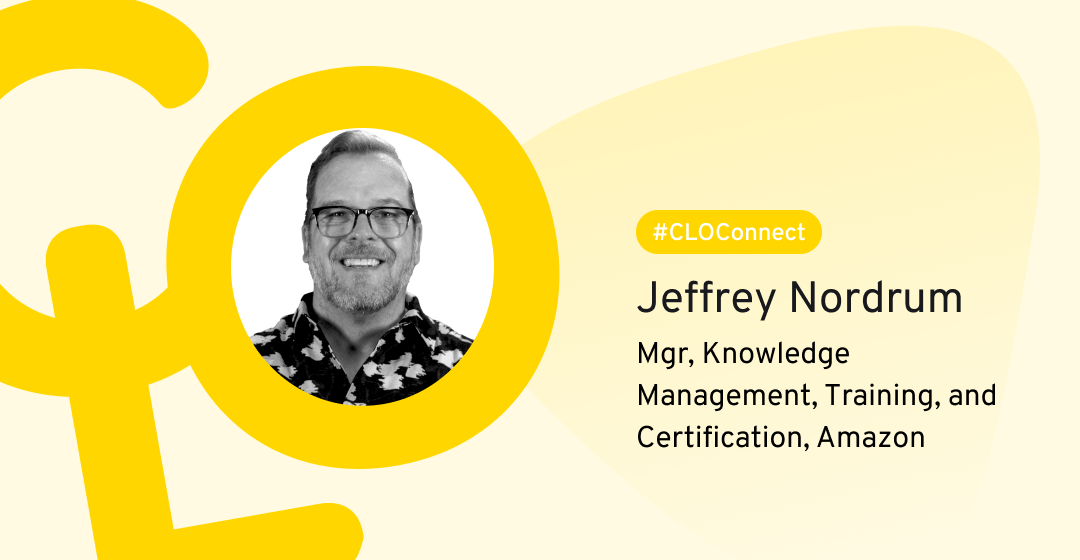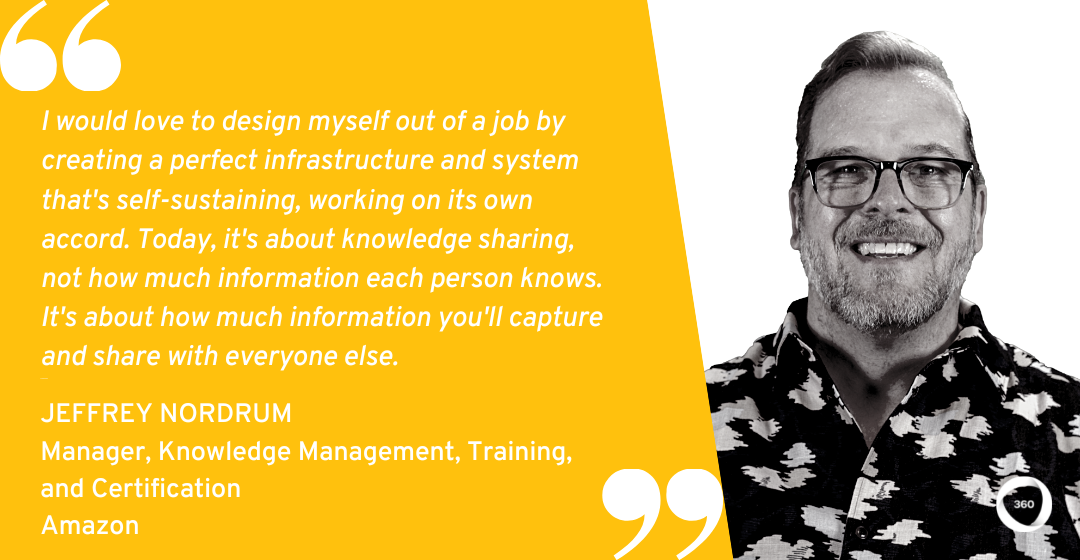
Designing Yourself Out of a Job: Jeffrey Nordrum's 4 Steps to Scaling Knowledge Management at Amazon
Expanding a team or practice that scales effectively and doesn’t result in siloed functions can be challenging.
With the pace at which technology changes, many knowledge management teams are finding it increasingly difficult to support and provide their people and customers with up to date information and training.
That’s why scaling knowledge management practices and teams and developing self-sustaining solutions is critical.
So, is there a practical approach you can use to scale your knowledge management practice that makes an impact? And can you integrate learning and development with knowledge management at the same time?
In this interview, I speak with Jeffrey Nordrum, Manager of Knowledge Management, Training, and Certification at Amazon, about his knowledge management journey, how he aims to design himself out of a job, and why integrating learning and knowledge management is key.
Read on to hear why scaling the knowledge management team is so vital for a global organization like Amazon.
Loving what you’re reading? Come and join the L&D Collective for more great learning insights, resources, and events!
The journey to knowledge management
Jeffrey has been at Amazon for over six years, but his career started long before.
“I minored in computer information systems, had an internship at Baker Systems in St. Cloud, and worked in information technology.” Jeffrey worked as a technical support specialist helping people fix their computers. Through that process, he encountered the corporate learning environment at a time when Outlook was first rolled out across organizations.
“I started to train the corporate world on how to use Outlook,” he says, “and it was at this time that I started to uncover how technology, the internet, and the related possibilities linked.”
That work led Jeffrey to a startup in Los Angeles that developed computer-based training on CD ROMs for Fortune 500 companies as a multimedia developer, programmer, and designer. He got interested in instructional design, leading him to Boston, where he further developed his skills and found new opportunities.
Looking for more expert insights? Find out how L&D leaders at Amazon, WhatsApp, Klaviyo and more are driving growth with the right L&D strategy.

You have questions–the experts have the answers
By downloading, you agree to our privacy policy.
The challenges of knowledge management
Knowledge management started to resonate with Jeffrey when he recognised that great information can be difficult to access.
The first time he put it all together was when he started at Amazon Global Robotics in 2016. When he arrived, he was asked to develop a new program to support the organization’s maintenance technicians to properly maintain and troubleshoot their robotic equipment at their sites.
“In this scenario,” he explains, “my perspective was focused on the needs of the organization and stakeholders. Technology changes so fast, and as a result the content needed to train people changed a lot— it was tough to dedicate such a large amount of time to this.”
“The question became: how do we develop programs and content to support that ongoing change and provide multiple ways to access that information not just through an eLearning course or an LMS, but through a knowledge center, a question-answer, or a wiki?”
The question became: how do we develop programs and content to support that ongoing change and provide multiple ways to access that information not just through an eLearning course or an LMS, but through a knowledge center, a question-answer, or a wiki?
There was also some added complexity for content that needed to be localized. If you have to localize the content, it can double, triple, or quadruple the information you have to manage over time.
“These were the main challenges that we faced in the robotics team at Amazon, and that's what led me here,” he says. “I moved teams in 2021, and now I lead our technical knowledge management, training, and certification team, developing our programs to support the technology that enables our physical retail stores.”
Related: What is Knowledge Management and Why is it Important for UK Learning Organisations?
Four steps to scaling a knowledge management team
In Jeffrey's experience, expanding a knowledge management team is a journey–you should be prepared to fail forward.
“We have to make mistakes and understand what's going on. In the past several years, I've been able to make those mistakes. Honestly, I haven't found the right stride, but I think I'm honing in on that right now to bring these worlds together and build out that team.”
1. Nurture the growth and ownership mindset
First and foremost, Jeffrey explains, scaling your knowledge management team starts with finding those people who have the growth and ownership mindset.
“These people understand what scaling means,” he says. “I still find that there are a lot of people who have experience in using certain tools and technologies and are working to develop them, but that doesn't mean that they can scale.”
“What people like to sell themselves on is that they're an expert in a certain tool or technology, but it's more about having somebody who understands what that larger picture means.
Related: Enabling Knowledge Sharing: CloudBlue’s 3-Step Approach to Learning Curation
2. Aim to design yourself out of a job
Next, Jeffrey says he would love to design himself out of a job by creating a perfect infrastructure and system that's self-sustaining, working on its own accord.
“I think that's what we should be aiming for in this day and age” he says. “It is about knowledge sharing, not how much information each person knows. It's how much information you'll capture and share with everybody else—that's what I want to achieve with the team I’m growing.”

Jeffrey has broken his team down into four main functions. He says “this structure ensures optimum communication, so people don't become siloed. We work together to produce these programs and final deliverables.”
“What's been helpful for us is that we have implemented a single intake process to be able to manage our work more effectively as well as moving to two-week sprints. This helps us be more transparent with the organization in terms of what we're working on.”
3. Intertwine learning and knowledge management
Over the years, and looking back, Jeffrey wonders why learning and knowledge management aren’t more integrated than they are.
“I think learning and knowledge management need to be integrated because it is about that re-access of information that people are going to need,” he says. “Once you learn something, how much are you going to remember? There's the forgetting curve: if you don't use it, you lose it, and after 30 days, if you haven't touched any of it, it's just completely gone.”
“But I think you're going to remember the location of that information. So, learning is like a fork to the knowledge and information you need. That's what I am looking at, and we're developing our processes to make that an integral part of our learning programs.”
An integrated learning and knowledge management program is fundamental for Amazon. “My team provides formal trainings where often, someone learns something new because the technology has been developed at Amazon, and so they wouldn’t have gotten exposure or experience anywhere else.
“This means we need much more of a high-fidelity, high-touchpoint training program to guide people through,” he says. “But once we release them into the wild, we want them to be successful in being able to help manage all of the technology they need to install, support, and troubleshoot.”
Once we release them into the wild, we want them to be successful in being able to help manage all of the technology they need to install, support, and troubleshoot.
“We know it’s impossible for people to memorize everything. So, we're working towards having a knowledge center that's going to be used as part of the support mechanism that people can go back and review.”
4. Define how the learning will look
Finally, Jeffrey says integration also depends on how the learning will look and its importance to the audience.
“What is important that people need to pay attention to?” he says. “Here's how we can build and make sure that we're trying to change the behavior and a different way of thinking for our customers or our audience, but knowing too, that they also have this other support mechanism within the knowledge center itself.”
“And there are a lot of other knowledge management tools out there we can leverage. There are question-answer systems and wikis, and I have explored many of those as well.”
Jeffrey's four-step approach for scaling a knowledge management team showcases the benefits of collaborative learning. By facilitating collaboration between the four functions within his team, Jeffrey ensures that they are not becoming siloed and, in turn, is creating a system that is moving towards becoming self-sustaining.
Measuring the impact of scaled knowledge management
Jeffrey has identified that the team needs to work towards overcoming the challenges around gathering metrics and data and showing the result they are making.
“Like many knowledge management teams, Jeffrey explains that he and his team don’t have solutions in place that allow them to get to the data. “That's what we need to solve— we need to be able to identify what people want and how we should create and maintain our content.”
As Jeffrey explains, if you can see how often your content is being accessed, you will be able to prioritise what to create or update on a quarterly or more frequent basis. But when you update that content at your knowledge center, your eLearning has to be updated, and trainers have to be part of that process to update facilitator guides.
“That's the other piece,” he says. “When something changes, how do you re-communicate that to people? Will they need to retrain? What's changed within your knowledge articles? That's been a big piece and we're just scratching the surface of this now.”
In the end, Jeffrey explains that the approach has been about creating and supporting the self-service of customers. “We're asked to be able to check our own groceries at the grocery store, but there's also that expectation for each coming generation that they're used to that.”
“And I think it's a good expectation that we need to be able to raise to be able to provide self-sustaining knowledge management. To manage that contract properly, you must have some parameters.”
Related: A 2-Part Collaborate, Learn, and Adapt Framework: Knowledge Management Storytelling at iDE
Three expert tips for scaling knowledge management
When you’re looking to scale your knowledge management practice, Jeffrey’s advice is to understand web development fundamentals.
1. Understand web development fundamentals
The one element that has helped Jeffrey be successful is learning web development like HTML, CSS, and JavaScript–everything is built on that foundation.
“You don't have to be an expert on these fundamentals,” he says, “but just to be conversant. Everything you develop is still using some basic principles, and you'll be amazed at what you can break or modify on your own without having to request that as a resource.”
2. Work back from the customer
Second, in Jeffrey’s experience, you should get to know your customer, take the time to put together personas, and understand what motivates them.
“Also, being able to shadow people is the best thing. You’ve got to get out front and center, put yourself in your customers’ shoes, and observe. I think that observation tells you so much information.”
Being able to shadow people is the best thing. You’ve got to get out front and center, put yourself in your customers’ shoes, and observe. I think that observation tells you so much information.
3. There’s no technological silver bullet
Jeffrey’s third tip is that no one technology does it all.
“Within learning and knowledge management, an organization will have 20 to 25 technologies to manage and maintain all these different things—from your microlearning to learning management to your knowledge center. If somebody's selling you on a technology as a one-size-fits-all, be wary and put on your critical thinking hat.”
Thanks to Jeffrey for sharing his four-step approach to scaling your knowledge management practice with us!
Looking for more insights on knowledge management and learning and development? Check out Joe Ryan’s three-step deep dive investigation approach for unlocking domain knowledge at Maltego and how Adrian Waite at Boehringer Ingelheim is training leaders to make their teams’ collective working a more performative experience.
Want more peer insights on transforming workplace learning? Sign up to become a member of the L&D Collective, and check out our other #CLOConnect interviews with top L&D leaders on driving growth and scaling culture through Collaborative Learning. Or you can subscribe (below 👇) to our weekly newsletter to receive our latest posts directly in your inbox.

